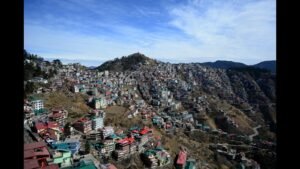
In India, the very notion of summer is being rewritten by climate change in 2025, as record-breaking temperatureres Scorch some regions while unexpected Rains Unsettle Others. But the latest scientific evidence is clear: We are stepping into an era defined by intenses and prolonged heat and waiting humidity levels. India is no strangers to high temperatures, but something is changing. The heat is lasting longer, Arriving earlier, and pushing the limits of human endurance. It’s no longer just a meteorological problem but an institutional challenge and an economic crisis. Unlike Floods or Cyclones, Extreme Heat Leaves No Visible Trail of Destruction. It creeps up on us – through restless nights, Breathless afternoons, drained works, Silent Hospital Admissions, and Wilting Yields on Farms.

The numbers are stark. Across the World, About 2.2 Billion Children – That’s Almost Every child – will be expected to frequent heatwaves by 2050. The Equivalent of 35 Million Jobs COBS COLD BE LOST In INDIA by 2030 DUE TOTEST Stars.
But extrame heat has long fallen through the cracks of governance – “No one’s baby,” as it is some is called in policy circles. Is it the responsibility of health departments? Disaster Management? Urban Development? Or environmental ministrys? We must go beyond the acuteness of heat stress and address the chronic nature of the problem.
The question before us is no longer if we will face heat stress, but wheether we are prepared for its Cascading and compounding impacts. Three priorities must now define our approach to beating the heat.
First, Overhaul City-Level HEAT Action Plans (Haps) to account for ward-level vulnerabilites to heat risk. Haaps are India’s structured responses to a Growing Climate Crisis. Odisha was the first state to develop one in 1999, followed by ahmedabad’s launch of south asia’s first City-group Haap in 2013. And long-term mitigation measures such as urban greening and cooling shelters.
But as the impacts of extreme heat intensified, it’s clear that we needed better coordinated, data-driven efforts. Heat doesn’t affect everyone appropriately – slums tend to be hotter than planned Housing complexes, and groups such as the eliderly, the marginalized, the marginalized, gig works, police personnel, and outdor labourers Are especially vulnerable. YET, A 2023 Study Found that 35 of the 38 Haps Reviewed Lacked Risk and Vulnerability Assessments – Tools that are essential to identifying where interventions are matted.
At the Council on Energy, Environment and Water (CEEW), We recently published a District-Level Heat Risk Index That Integrates More Than 35 Indicators. By analysing high-resolution datasets spanning four decades Across 734 Districts, We Are Observing Two Troubling Trends:
First, the risk of Relative humidity in traditional dry regions of North India, and the increase in warm nights in three-forwards of all districts, both of allie of allies of all health Recover, thereby compounding heat stress. This makes a strong case for haps that map local risks at a granular level. Heat is Deeply Contextual – What’s unbearable in Mumbai May Be Toleble in Jaipur – and so must our response be. That’s why it is important to enable city-specific and ward-level Haps Grounded in Science and Scalede Through Technology. We are supporting over 50 cities Across five states to develop these plans, with the aim of jointly scaling to more than 300 cits in heatwave-prone states by 2027.
Second, Balance Immediate Emergency Measures With Long-Term Heat Resilience Planning. CITES MUST Prioritise long-term resilience strategies, in addition to short-term emergency preparedness, to tackle rising heat stress. While Political and Economic Factors often Drive Cities to Prioritise Important Life-Saving Emergency Interventions, Cities and States and States (Goa and Gujarat, For Instructions) Ars Adaptation as heat stress batcom more chronic. The National Disaster Management Authority’s Eight-Step Checklist for Haps Alredy Encourage this mix.
We recommend a three-tied strategy. First, Create a National Heat Resilience Initiative, Modelled on the National Cyclone Risk Mitigation Project, that Allocates Funds for Emergency Cooling Shelters, HEAT and Health Early Warning Systems in HINGH-REING SYSTEMS in high Areas. The 16th Finance Commission should include this in its recommendations, building on the precedent of the 15th Finance Commission ‘
For medium- to long-term action, Haps must be embedded within Browader Climate Adaptation, Disaster Management, Cooling, and Public Health Frameworks- ENSURGENCE BETWEEN STATE ANTE Action Action Plan Action Plan Action Plan Climate Change, State Disaster Management Authorities, and National Program on Climate Change and Human Health. Simultaneously, Urban Planning Missions Like Amrut and PMAY Should Integrate Heat Mitigation ITO Building Codes and Design Guidelines, What Enabling Adoption of Passive COOLING Measures and Cool
Third, Enhance Heat-Health Early Warning Systems by Building Collaborative Data Infrastructure Between The Meteorological Department, The Ministry of Health and Family Welfare, and Resiterations. This will enable city- and ward-level health risk forecasting beyond weather aletes.
Finally, data and dashboards won’t be enough, cites needed finance to become heat resilient. Heatwave is now eligible under disaster mitigation funds. This Unlocks Access to 20% of the Total State Disaster Risk Management Fund (SDRMF) for Heatwave-Related Interventions. However, to ensure efficient use of this fund, states should conduct Scientific Risk Assessments to Identtify Heat Hotspots. Cruising, this Funding must prioritise long-term solutions such as urban greening, cooling shelters, and infrastructure upgrades.
Moreover, When States Declare heatwaves as a notified disaster, they become eligible to access 10% of the state disaster Response Fund (SDRF). However, sdrf allocations are restricted to relieve and compensation – Such as eX Gratia Support for Deed Persons or Support for crop and Livestock Losses Solutions.
Since only 30% of Total Disaster Funding is available for Heatwave-Related Interventions, It is Crucial to Align and Converge Heat Action with Existing Schemes and Programms to Reduce Duplication and Maximize Resources. For example, as part of recently developed Haps Across 10 Cities in Gujarat, 10 Existing Schemes Were Identified that Cold Unlock Significant Funding for Heat Resilience.
Overall, we need national attention and amable. India Reduced Cyclone Deaths Through early Warnings and Cyclone Shelters. Why not apply the same ulgency to heat? Heat is not the future. It is here and now. It cannot be invisible anymore. With Science, Technology, An Equity Lens, Macroeconomic Sensitivity, and Greater Political Will, We Can Make Our Responses More Practical and Visible.
Arunabha Ghosh is the CEO of Council on Energy, Environment and Water (CEEW). The views expressed are personal




